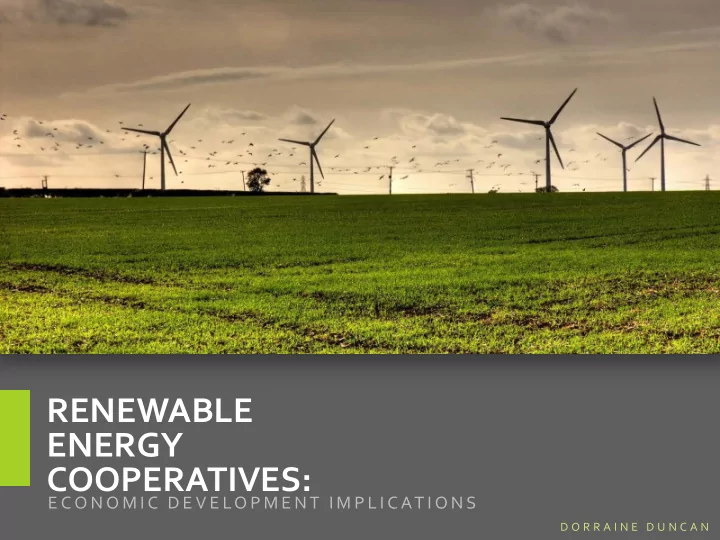

RENEWABLE ENERGY COOPERATIVES: E C O N O M I C D E V E LO P M E N T I M P L I C AT I O N S D O R R A I N E D U N C A N
OVERVIEW What are RE cooperatives? Logic model Methodology Findings Economic implications Best practices
W H A T A R E R E N E W A B L E E N E R G Y C O - O P E R A T I V E S ?
Renewable Energy Co-ops A democratic membership organization that facilitates renewable energy generation where a community (local or national) has a financial investment in a renewable energy project, whether by complete ownership or in partnership with others. www.respublica.org.uk
LOGIC MODEL Long -term Short -term Capabilities Outputs Inputs Impacts Intervention Impacts & Actions • Reduced Problems • Develop • RE and carbon initiating need ownership energy emissions for RE co-ops • Improved model Conservation citizen • Energy Knowledge • Incorporate • Local • Education decentralization Clean energy Cooperative community production • Improved engagement • Price stability • Advances in relationship • Open for energy policy with Utility Membership • Member • Employment economic • Community • Changes in • Secure PPA Participation • Revenue Improvements community relations • Install RE • Local • Utility bill • New plant community credits business knowledge development Rival explanation: Rival explanation: Rival explanation: Gov/utility initiative Government or Government or with community utility initiative utility initiative focus Regional Energy Policy | Community Relations
METHODOLOGY Catalog characteristics of RE co-ops. How can these characteristics create economic development? o A case survey Dataset consisting of RE co-ops 60 cases worldwide o Data Collection Consortiums of shared renewable energy projects Journals/reports of energy cooperatives Journals/reports of shared energy
Biofuels/Biomass Hydro Wind Mixed- Use Solar
MEMBERSHIP OF CO-OP Min: 35 Median: 573 Max:50,000
Min: 35 Median:200 Max: 1375
FINDINGS Inputs Interventions External conditions Capabilities and Actions Outputs Short term impacts Long term impacts
I N P U T S
D R I V E R S F O R C R E AT I O N O F R E C O - O P S 40 35 30 25 Number of Co-ops [Author Analysis] 20 15 10 5 0 Environmental Energy Community Economic Service Marginalized Lower costs/Stabilize Sustainability Independence Empowerment returns/growth Communities prices
T Y P E S O F F I N A N C I A L I N V E S T M E N T Membership fee and share purchase 10% No information 12% Purchase of 1 share 38% Subscription fees/ work equity 15% Membership fee 25% [Author Analysis]
I N T E R V E N T I O N S
Community-led Ownership: The co-op was responsible for implementing and financing the project via wholly community-led initiatives Joint Ownership: An energy developer was responsible for implementing the project but the co-op purchases a stake in the project Public/Community-led Ownership : A public body was involved in the implementation/financing of the project and the co-op has part or full ownership www.respublica.org.uk [Content Analysis]
E X T E R N A L C O N D I T I O N S
E N E R GY PO L IC Y 70 [Author Analysis] 60 50 Number of Co-ops 40 30 20 10 0 PPA RE portfolio Tradable REC FiT tax incentive Net metering standards
O U T P U T
R E N E WA BL E E N E R GY SO U R C E S 45 40 [Author Analysis] 35 30 Number of Co-ops 25 20 15 10 5 0 solar wind hydro biofuels/biomass
ELECTRICTY PRODUCTION Max: 102MW/h Median: 855kW/h Min: 6kW/h 1 home – 1.25kW/h 800 homes- 1MW/h https://www.eia.gov/
Max: 1.9MW/h Median: 103.5kW/h Min: 22.05kW/h
I M PA C T S
SHORT-TERM OUTCOMES Number of Co-ops 0 5 10 15 20 25 30 35 40 Revenue/Dividends/Returns Education/ Skills Training Employment New Energy Access Reduced energy prices/Stability Energy Efficiency Discounts on other products
LONG-TERM OUTCOMES Number of Co-ops 0 5 10 15 20 25 30 35 40 Reduced Carbon Emissions Community Improvements New Business Development
E C O N O M I C D E V E L O P M E N T
IMPLICATIONS Electricity price stabilization Building resilient communities Education and training for green industries Growth in green energy industry
WEATHERIZATION PARTIES 1. Identify leaks in windows, doors, walls 2. CEF staff provides training on sealing cracks, installing window kits 3. Teams go house to house weatherizing the homes 4. Materials free for co-op members
COMMUNITIES www.census.gov/2010census/data/
OUTPUT
B U S I N E S S D E V E L O P M E N T
BEST PRACTICES Start-up costs Crowd sourcing • Community Partners Leveraging anchor institutions • Co-op culture 43% of GA population are members of an EMC • Creating Economic Development? Supportive policy framework • Diverse citizen participation •
THANK YOU ! DDUNCAN42@GATECH.EDU
Recommend
More recommend